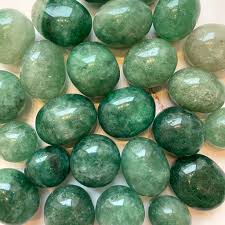Green quartz, a captivating gemstone admired for its vibrant color and unique properties, has a rich history and a variety of forms that make it stand out in both the world of gemstones and crystals.
Known for its soothing hues ranging from pale mint green to deep emerald, green quartz has captured the attention of jewelers, collectors, and spiritual practitioners alike.
This article explores the origins of green quartz, its different varieties, and its journey from the earth to becoming a sought-after stone in both decorative and healing circles.
Whether you’re a gem enthusiast, a collector, or simply curious about the unique world of quartz, this guide provides a deeper understanding of green quartz and its many facets.
1. What Is Green Quartz?
Green quartz is a variety of the mineral quartz (SiO2), which is one of the most abundant minerals in the Earth’s crust. Quartz comes in a wide range of colors, and the green variation occurs due to the presence of certain trace elements or inclusions that give the mineral its distinctive hue.
Physical Properties of Green Quartz
- Hardness: Green quartz has a hardness of 7 on the Mohs scale, which makes it durable enough for use in jewelry and other ornamental applications.
- Crystal System: Quartz crystals typically form in the hexagonal crystal system, often seen in prismatic or pointed forms.
- Transparency: Green quartz can range from translucent to transparent, depending on the specific type and the conditions under which it formed.
2. Origins of Green Quartz
The origins of gre en quartz can be traced to the geological processes that produce quartz crystals. Quartz forms when silicon dioxide crystallizes under certain environmental conditions, such as high pressure and heat within the Earth’s crust. The presence of various trace elements or natural radiation can cause the crystal to develop a green color.
Mineral Impurities
The green color in quartz is typically caused by the presence of minerals like chromium, vanadium, or iron. For example, chromium and vanadium are often responsible for the green hues in quartz, especially in stones like green amethyst.
Locations Where Green Qua rtz Is Found
Green quartz is found in various parts of the world, with notable deposits found in Brazil, the United States, Madagascar, and Russia. The conditions in these regions provide the right combination of minerals, heat, and pressure for the creation of gree n quartz.
- Brazil: Known for producing high-quality quartz crystals, Brazil has several mines where green qu artz, including green amethyst and prasiolite, is found.
- United States: Some green quar tz, particularly in the form of prasiolite, is found in the southwestern parts of the U.S. in Arizona.
- Madagascar: Madagascar is a significant source of various colored quartz varieties, including green q uartz, thanks to its rich geological diversity.
- Russia: Russia has also contributed to the discovery of quartz varieties, including green forms, particularly those used in jewelry and ornamental carvings.
Varieties of Green Quartz
Gre en quartz exists in several distinct varieties, each with its own unique properties and uses. While they are all part of the quartz family, the color and origins of these varieties can differ.
Prasiolite (Green Amethyst)
Prasiolite, sometimes called “green amethyst,” is one of the most well-known and sought-after varieties of green quartz. Despite its name, prasiolite is not technically a form of amethyst but is instead a natural green form of quartz. Its distinctive pale green to olive green color is the result of natural irradiation or heat treatment of amethyst crystals.
- Formation: Prasiolite forms from amethyst through heat treatment, either naturally (through volcanic activity) or artificially in a laboratory. The amethyst crystal’s original purple hues change to green when exposed to heat or radiation.
- Uses: Prasiolite is highly prized in jewelry, particularly in pendants, rings, and earrings. Its soft green tones are often used to create elegant, understated pieces.
Green Aventurine
Green aventurine is another popular variety of green quartz, often recognized by its shimmering, speckled appearance. It gets its name from the Italian word “a ventura,” meaning “by chance,” due to the way its characteristic glimmering effect, called aventurescence, is formed.
- Formation: Green aventurine is a form of quartz that contains small inclusions of mica or hematite, giving the stone its distinctive sparkle. These inclusions reflect light, creating the stone’s signature glimmer.
- Uses: Green aventurine is commonly used in making jewelry, beads, and cabochons. It’s also used for carving into ornamental pieces due to its durability and vibrant appearance.
Chrysoprase
Chrysoprase is a translucent to opaque green variety of chalcedony (a microcrystalline form of quartz). It is one of the most prized green gemstones, known for its rich, apple-green color.
- Formation: Chrysoprase gets its green color from trace amounts of nickel, which is incorporated into the stone as it forms. It is often found in limestones or other rocks that have been exposed to nickel-rich groundwater.
- Uses: Chrysoprase is frequently used in fine jewelry, particularly for high-end pieces such as rings, necklaces, and brooches. Its bright, almost glowing color makes it highly attractive.
Green Quartz (Natural Green)
In addition to prasiolite and aventurine, there are other forms of natural green quartz that don’t fall into the “aventurine” or “amethyst” categories. These include varieties that can be found with different green hues, ranging from light mint green to deeper forest green. These forms of quartz can be used in all kinds of applications, from raw crystals for collectors to polished stones for various decorative uses.
- Formation: These forms of quartz can be the result of various natural factors, such as trace elements or the influence of local geological conditions, including the presence of chromium or iron.
- Uses: Natural green quartz is often cut into cabochons or faceted for use in jewelry or ornamental carvings. It is also used in crystal healing and feng shui practices.
The Metaphysical Properties of Green Quartz
Many people believe that green quartz, like other crystals and gemstones, carries certain metaphysical properties that can aid in healing and personal growth. Green quartz is often associated with growth, renewal, and balance.
- Healing: Green quartz is thought to have a soothing effect on the emotional body, helping to calm the mind and reduce stress. It is often used in meditation or as a talisman to promote emotional well-being and healing.
- Abundance and Prosperity: Green, in many cultures, is considered the color of wealth and abundance. Many people use green quartz to attract prosperity and success, whether in personal, professional, or financial matters.
- Physical Healing: Some crystal practitioners believe that green quartz can support physical healing, particularly in relation to heart health, circulation, and detoxification.
Caring for Green Quartz
Green quartz is relatively durable, with a hardness of 7 on the Mohs scale, meaning it can withstand everyday wear and tear. However, like all gemstones, it requires proper care to maintain its beauty.
- Cleaning: To clean green quartz, use warm water and mild soap, avoiding harsh chemicals. Gently wipe the stone with a soft cloth to avoid scratching the surface.
- Storage: Store your green quartz jewelry or crystals in a soft pouch or jewelry box to prevent scratches and damage from other harder stones
- Protection from Heat and Chemicals: While green quartz is heat-resistant, prolonged exposure to high temperatures or harsh chemicals should be avoided to prevent damage.
Conclusion
The fascinating origins and varieties of green quartz offer a captivating exploration into the world of gemstones and crystals. From prasiolite’s delicate green hues to the glittering specks of green aventurine and the vibrant, translucent tones of chrysoprase, green quartz is a versatile and beloved stone in both the jewelry and metaphysical communities. Whether you’re wearing it as an adornment, using it for healing purposes, or simply appreciating its beauty, green quartz continues to capture the hearts of many, offering both aesthetic and spiritual value.





